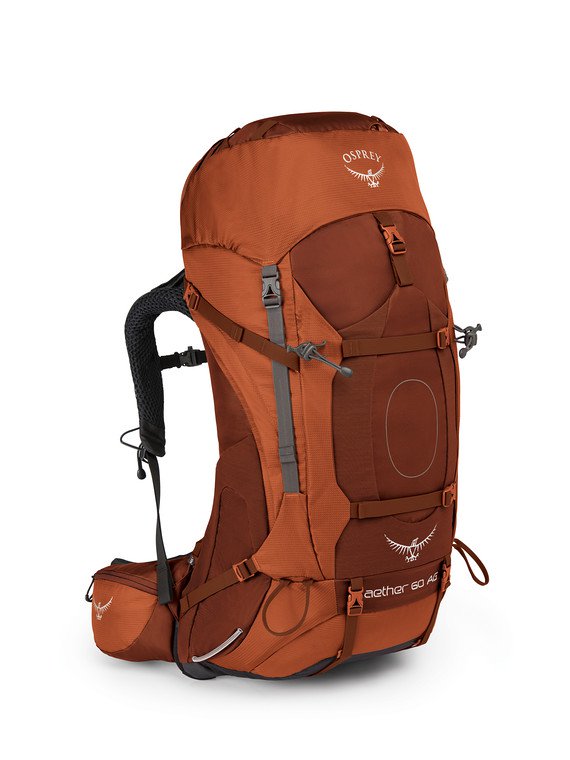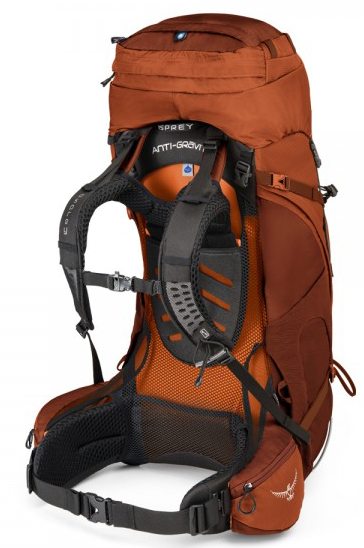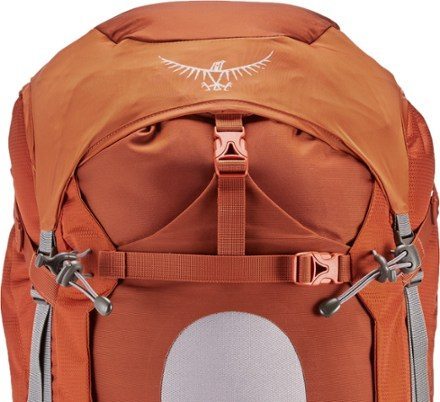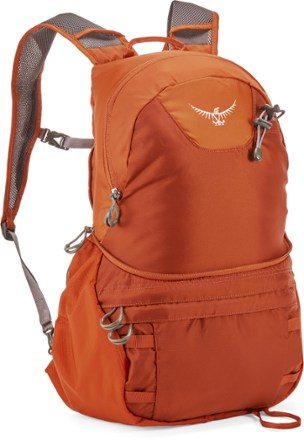
Osprey Aether AG 60 Pack
Size Tested: Medium
Stated Weight: 2335 grams
Features:
- Removable top-lid converts to DayLid™ daypack
- Dual upper side compression straps
- Dual access side stretch mesh pockets
- Zippered hipbelt pockets
- Stow-on-the-Go™ trekking pole attachment
- Additional main compartment access
- Large stretch mesh front panel pocket
- Dual front compression straps with StraightJacket™ compression
- Dual ice tool loops with bungee tie-offs
- Zippered sleeping bag compartment with removable divider
- Removable sleeping pad straps
- Integrated FlapJacket™ cover for lidless use
- Internal hydration reservoir sleeve
- Side panel zip access to main compartment
MSRP: $290
Reviewer: Waist 32”, Torso 19”
Test Location: Solukhumbu, Nepal
Days Tested: ~35
Intro
Osprey’s new Aether AG line builds on the success of the original Aether, which was one of Osprey’s bestselling backpacking bags for hauling heavy loads. The new “AG” version features an interesting brain that converts into a daypack; Osprey’s new ventilation-focused “Anti-Gravity” suspension system; and several other unique features.
In order to see how Osprey’s revamped Aether performed, I tested the Aether AG 60 for over a month while trekking in the Nepal Himalaya, where I used it as my only bag for both travel and backpacking.
Fit
Osprey’s technical packs generally come in three sizes, and it’s wise to measure the size of your back using their fit guide to get an idea of which size would work best for you. My back length is 19” and I fit well into the Medium, though my waist (32”) was almost too small for the Medium’s hip belt.
If you don’t fit perfectly into the correct size at first, it’s also easy to make smaller adjustments to the torso length as needed, and the hip belt and straps are also interchangeable, which is worth noting if your torso length and waist size don’t correspond to the same pack / hip belt size.
Hip belt and Shoulder Straps
The Aether AG 60’s hip belt and shoulder straps are very comfortable. The hip belt provides adequate cushioning and support without any uncomfortable rubbing, and the tensioned mesh of the Anti-Gravity suspension system helps keep the hip belt very snug around your waist. As a result, the pack almost stays on by itself with just the tension from the hip straps, even when they’re unbuckled. The shoulder straps are well-padded but light, and the tapered design includes more padding higher on the shoulders where you need it.
Suspension & Carrying Capacity
As mentioned earlier, the Aether AG 60 utilizes Osprey’s new Anti-Gravity suspension system, which consists of a mesh wrap that extends from the hip belt all the way to the shoulders and is designed to contour tightly to any user’s back. Additionally, there are stiff straps that extend from the shoulder to provide a secure fit and distribute the load evenly.

Overall, I was thoroughly impressed by the Anti-Gravity system — it snugly hugged my hips and lower back and provided ample ventilation during muggy Himalayan days. When carrying loads of equivalent weight, the Aether AG 60 was significantly more comfortable than the old Osprey Argon 85, which I’ve loved for many years but doesn’t feature the Anti-Gravity system.

Throughout my testing period in the Aether AG 60, I carried loads from 15 to 65 pounds and was very impressed by the pack’s versatility across this range (for an extended backpacking trip, I’d probably be comfortable with loads up to 55 lbs). The Aether AG 60’s upright shape and snug back panel keep weight closer to the body than both the Dakine Poacher 45 and the Osprey Argon 85. This is likely due in part to the Anti-Gravity system as well as the compression straps on the sides and front of the pack that cinch down to keep weight tight or accommodate smaller volumes.
Organization & Access
In addition to the top drawstring opening, access to the Aether AG 60’s main compartment is enhanced by a zipper that runs up one side, though I didn’t find myself using this zipper much when the pack was fully stuffed. An adjustable and removable divider at the bottom of the pack creates a separate sleeping bag compartment, and the Aether AG 60 also features removable sleeping pad straps.
I’ve had a hard time finding packs with useful outer water bottle holsters, but the Aether AG 60’s are incredibly well-designed. They’re made of a tough elastic and are easy to access while wearing the pack but still keep a full-size Nalgene secure.
The outer elastic kangaroo pouch is really useful for storing wet clothes on the trail, and Osprey has replaced the middle, abrasion-prone section with a patch of tougher nylon.
The hip belt features a surprisingly high-volume zippered pocket on each side, and they’re large enough to easily hold my Canon G16 point-and-shoot camera in its bulky hard case.

The Aether AG 60 also features a low-profile flap to cover the drawstring opening and cinch down the pack when you’ve removed the brain, which Osprey has named the “FlapJacket™.” This subtle addition makes it a lot easier to lighten your load by ditching the brain completely, and I also often found myself keeping the brain in daypack mode, stuffing it inside the main compartment of the Aether AG 60, and using the flap to keep everything tight and covered.
Built-in Daypack
The most unique aspect of the Aether AG 60 is the brain, which converts into a miniature daypack — a feature that Osprey calls the DayLid™. Using a bag’s brain as a smaller pack isn’t a completely novel idea, as many manufacturers (including Osprey) have created brains that convert into hip packs in the past. However, in my experience these hip packs can only carry a layer and a few granola bars but are very limited in their ability to accommodate full-day excursions while backpacking, and especially fall short in carrying sufficient water.
Osprey addressed this issue by adding padded straps and an extra compartment to the brain that stuff into an isolated zip pocket when in brain-mode, but that allow for conversion into a ~20 liter backpack when the pocket is unzipped and expanded.

I was impressed by the functionality of the Aether AG 60’s brain daypack. The main compartment of the brain daypack has plenty of room for two liters of water (it has a built-in hydration sleeve and port), a few layers, snacks, a camera, and a small first aid kit. The smaller front pocket can hold a phone, wallet, Steripen, etc. I also rigged some elastic cord to the integrated loops on the brain which made for even more carrying capacity, and the brain daypack also includes a built-in elastic ice axe loop.
The shoulder straps of the Aether AG 60’s brain daypack are made of a soft mesh and are much more comfortable than I expected, and they have proven surprisingly durable throughout my 30+ day testing period. The brain daypack has an adjustable chest strap but no hip belt, which I never found myself missing. The only gripe I had with the brain daypack was that the large volume of the lower section of the pack tends to result in the contents of the pack bulging out in the bottom, especially with smaller loads.
In the past, I would generally bring my REI Flash 18 along on most backpacking trips to use as a daypack since it packs down to the size of a burrito and is very light at a stated weight of 284 g / 10 oz. Osprey’s DayLid™ system is meant to serve as a replacement for this kind of ultralight daypack, and for the most part does a great job doing so.

The Flash 18 has an even, tubelike shape while the Aether AG 60’s brain daypack forms a tapered shape necessitated by the need to act as a functional brain when not in pack mode. As a result, it’s much easier to access things at the bottom of the Osprey pack, especially because there is a second, lower zipper that accesses the main compartment. The Flash 18 only features a drawstring closure at the top, which makes finding gear at the bottom more difficult.
While the shape of the Aether AG 60’s brain daypack makes getting to your gear easy, the bulbous lower section makes effective weight distribution much more difficult compared to the cylindrical shape of the Flash 18. However, the Osprey’s shoulder straps are significantly more comfortable than those on the Flash 18.
So, it’s tough to say which pack is “better,” but overall Osprey has done a very good job, especially considering the Aether AG 60’s daypack also functions as the main pack’s brain. And the key takeaway here is that, with the Aether AG 60, I no longer feel the need to bring along a second pack for longer backpacking trips.
Durability
Osprey offers a lifetime guarantee on all their products, which makes it in their best interest to build strong packs. I showed the Aether AG 60 no mercy throughout my time in Nepal, and it weathered the abuse well. The Anti-Gravity mesh concerned me at first — it seems like the large area of mesh would be prone to catching and ripping. To my surprise, the mesh has proven very tough, and is showing no signs of wear so far. I don’t have reason to be concerned about its long-term durability so far, but I’ll update if I do experience any issues.
Who’s It For?
The Aether AG 60 is ideal for backpackers who are looking for top-notch ventilation, suspension, and a nifty integrated daypack. The 60 liter capacity would be ideal for trips up to 5 days for most backpackers, though careful packing could definitely stretch that time. It’s also ideal for travelers as it fits as a carry-on for many airlines and the brain daypack makes a great “personal item.” At $290, the Aether AG 60 is a high-end pack at a high-end price, but Osprey’s “All Mighty Guarantee” lifetime warranty policy makes that price easier to swallow.
Bottom Line
The Osprey Aether AG 60 is a great do-everything backpacking pack, and can easily accommodate a variety of load sizes. Its excellent fitting options are paired with a very effective suspension system, which makes for a very comfortable, well-ventilated pack. Finally, Osprey’s integrated daypack lid is a smart answer to a common backpacking need, and it performed well.

Have an old version of the pack. Not the lightest but tough and can carry weight more comfortably than any pack I’ve encountered. There’s a reason why you see many forest service workers on the trail with one of these.